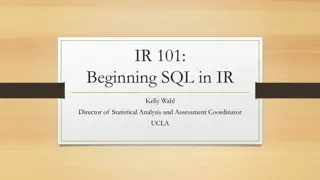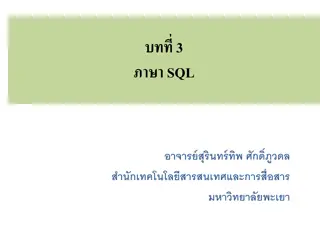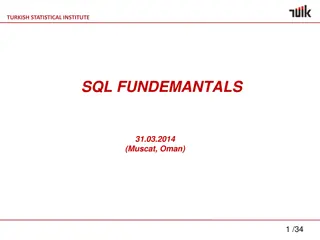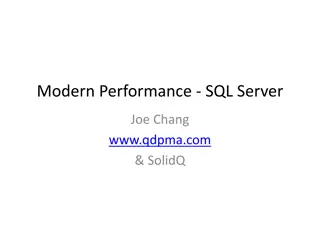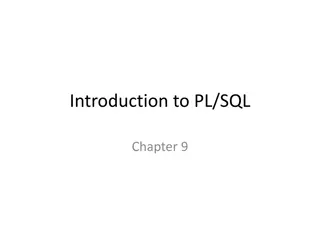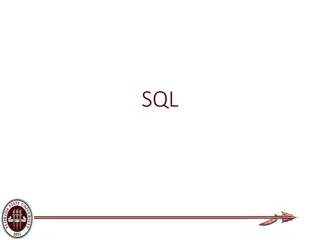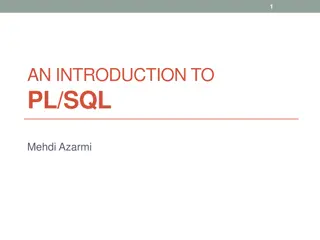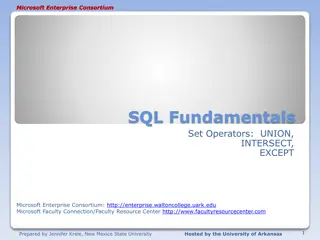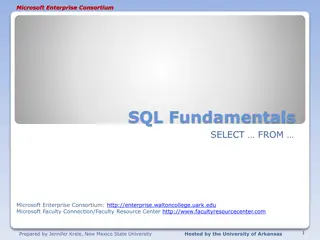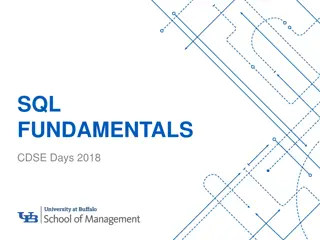
Introduction to SQL Concepts
"Learn about SQL, a standard language for querying and manipulating data. Explore basic single-table queries, multi-table queries, data manipulation language, data definition language, table structures, data types, and more."
Download Presentation

Please find below an Image/Link to download the presentation.
The content on the website is provided AS IS for your information and personal use only. It may not be sold, licensed, or shared on other websites without obtaining consent from the author. If you encounter any issues during the download, it is possible that the publisher has removed the file from their server.
You are allowed to download the files provided on this website for personal or commercial use, subject to the condition that they are used lawfully. All files are the property of their respective owners.
The content on the website is provided AS IS for your information and personal use only. It may not be sold, licensed, or shared on other websites without obtaining consent from the author.
E N D
Presentation Transcript
1. SQL introduction & schema definitions 2. Basic single-table queries Concepts In this section 3. Multi-table queries
SQL Introduction SQL is a standard language for querying and manipulating data SQL stands for Structured Query Language SQL is a very high-level programming language This works because it is optimized well! Many standards out there: ANSI SQL, SQL92 (a.k.a. SQL2), SQL99 (a.k.a. SQL3), .
5 SQL is a Data Manipulation Language (DML) Query one or more tables Insert/delete/modify tuples in tables Data Definition Language (DDL) Define relational schemata Create/alter/delete tables and their attributes
Tables in SQL Product PName Price Manuf Gizmo $19.99 GizmoWorks A relation or table is a multiset of tuples having the attributes specified by the schema Powergizmo $29.99 GizmoWorks SingleTouch $149.99 Canon MultiTouch $203.99 Hitachi
Tables in SQL Product PName Price Manuf Gizmo $19.99 GizmoWork s An attribute (or column) is a typed data entry present in each tuple in the relation Powergizmo $29.99 GizmoWork s SingleTouch $149.99 Canon MultiTouch $203.99 Hitachi NB: Attributes must have an atomic type in standard SQL, i.e. not a list, set, etc.
Tables in SQL Product PName Price Manuf A tuple or row or record is a single entry in the table having the attributes specified by the schema Gizmo $19.99 GizmoWorks Powergizmo $29.99 GizmoWorks SingleTouch $149.99 Canon MultiTouch $203.99 Hitachi
Tables in SQL Product PName Price Manuf Gizmo $19.99 GizmoWorks Powergizmo $29.99 GizmoWorks SingleTouch $149.99 Canon MultiTouch $203.99 Hitachi
Data Types in SQL Atomic types: Characters: CHAR(20), VARCHAR(50) Numbers: INT, BIGINT, SMALLINT, FLOAT Others: MONEY, DATETIME Every attribute must have an atomic type Hence tables are flat
Table Schemas The schema of a table is the table name, its attributes, and their types: Product(Pname: string, Price: float, Category: string, Manufacturer: string) Product(Pname: string, Price: float, Category: string, Manufacturer: string) A key is an attribute whose values are unique; we Product(Pname: string, Price: float, Category: string, Manufacturer: string) underline a key Product(Pname: string, Price: float, Category: string, Manufacturer: string)
Key constraints A key is a minimal subset of attributes that acts as a unique identifier for tuples in a relation A key is an implicit constraint on which tuples can be in the relation i.e. if two tuples agree on the values of the key, then they must be the same tuple! Students(sid:string, name:string, gpa: float) 1. Which would you select as a key? 2. Is a key always guaranteed to exist? 3. Can we have more than one key?
Declaring Schema Students(sid: string, name: string, gpa: float) CREATE TABLE Students ( sid CHAR(20), name VARCHAR(50), gpa float, PRIMARY KEY (sid), )
NULL and NOT NULL To say don t know the value we use NULL NULL has (sometimes painful) semantics, more detail later Students(sid:string, name:string, gpa: float) sid name gpa 123 Bob 3.9 Say, Jim just enrolled in his first class. 143 Jim NULL In SQL, we may constrain a column to be NOT NULL, e.g., name in this table
General Constraints We can actually specify arbitrary assertions E.g. There cannot be 25 people in the DB class In practice, we don t specify many such constraints. Why? Performance! Whenever we do something ugly (or avoid doing something convenient) it s for the sake of performance
Summary of Schema Information Schema and Constraints are how databases understand the semantics (meaning) of data SQL supports general constraints: Keys and foreign keys are most important We ll give you a chance to write the others
1. The SFW query What you will learn about in this section 1. Other useful operators: LIKE, DISTINCT, ORDER BY
SQL Query Basic form (there are many many more bells and whistles) SELECT <attributes> FROM <one or more relations> WHERE <conditions> Call this a SFW query.
Simple SQL Query: Selection PName Price Category Manuf Gizmo $19.99 Gadgets GWorks Selection is the operation of filtering a relation s tuples on some condition Powergizmo $29.99 Gadgets GWorks SingleTouc h $149.99 Photography Canon MultiTouch $203.99 Household Hitachi SELECT * PName Price Category Manuf FROM Product Gizmo $19.99 Gadgets GWorks WHERE Category = Gadgets Powergizmo $29.99 Gadgets GWorks
Simple SQL Query: Projection PName Price Category Manuf Gizmo $19.99 Gadgets GWorks Projection is the operation of producing an output table with tuples that have a subset of their prior attributes Powergizmo $29.99 Gadgets GWorks SingleTouc h $149.99 Photography Canon MultiTouch $203.99 Household Hitachi SELECT Pname, Price, Manufacturer PName Price Manuf FROM Product Gizmo $19.99 GWorks WHERE Category = Gadgets Powergizmo $29.99 GWorks
Notation Product(PName, Price, Category, Manufacturer) Input Schema SELECT Pname, Price, Manufacturer FROM Product WHERE Category = Gadgets Output Schema Answer(PName, Price, Manfacturer)
A Few Details SQL commands are case insensitive: Same: SELECT, Select, select Same: Product, product Values are not: Different: Seattle , seattle
LIKE: Simple String Pattern Matching SELECT * FROM Products WHERE PName LIKE %gizmo% s LIKE p: pattern matching on strings p may contain two special symbols: % = any sequence of characters _ = any single character
DISTINCT: Eliminating Duplicates Category Gadgets Photography SELECT DISTINCT Category FROM Product Household Category Versus Gadgets Gadgets SELECT Category FROM Product Photography Household
ORDER BY: Sorting the Results SELECT FROM WHERE ORDER BY Price, PName PName, Price, Manufacturer Product Category= gizmo AND Price > 50 Ordering is ascending, unless you specify the DESC keyword. Ties are broken by the second attribute on the ORDER BY list, etc.
1. Foreign key constraints 2. Joins: basics 3. Joins: SQL semantics What you will learn about in this section
Foreign Key constraints Suppose we have the following schema : Students(sid: string, name: string, gpa: float) Enrolled(student_id: string, cid: string, grade: string) And we want to impose the following constraint: Only actual students may enroll in courses i.e. a student must appear in the Students table to enroll in a class Enrolled Students Student _id cid grade sid name gpa 123 564 A 102 Bob 3.9 123 Mary 3.8 123 537 A+ We say that student_id is a foreign key that refers to Students
Declaring Foreign Keys Students(sid: string, name: string, gpa: float) Enrolled(student_id: string, cid: string, grade: string) CREATE TABLE Enrolled ( student_id CHAR(20), cid CHAR(20), grade CHAR(10), PRIMARY KEY (student_id, cid), FOREIGN KEY (student_id) REFERENCES Students(sid) )
Foreign Keys and update operations Students(sid: string, name: string, gpa: float) Enrolled(student_id: string, cid: string, grade: string) What if we insert a tuple into Enrolled, but no corresponding student? INSERT is rejected (foreign keys are constraints)! What if we delete a student? 1.Disallow the delete 2.Remove all of the courses for that student 3.SQL allows a third via NULL (not yet covered) DBA chooses
Keys and Foreign Keys Company CName StockPrice Country GizmoWorks 25 USA What is a foreign key vs. a key here? Canon 65 Japan Hitachi 15 Japan Product PName Price Category Manufacturer Gizmo $19.99 Gadgets GizmoWorks Powergizmo $29.99 Gadgets GizmoWorks SingleTouch $149.99 Photography Canon MultiTouch $203.99 Household Hitachi
1. SQL introduction & schema definitions 2. Basic single-table queries Concepts In this section 3. Multi-table queries
SQL operating on Tables (Lists of rows) BASIC TYPES MAP + FILTER REDUCE/AGGREGATE Int32, Single table query int64 SELECT SUM(c1*c2) FROM T WHERE condition GROUP BY c3; Char[n] Float32, SELECT c1, c2 FROM WHERE condition; T float64 Multi table JOIN SELECT c1, c2 FROM WHERE condition; T1, T2

